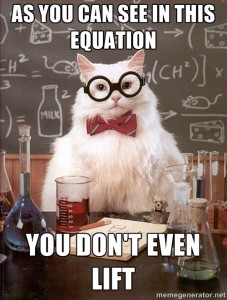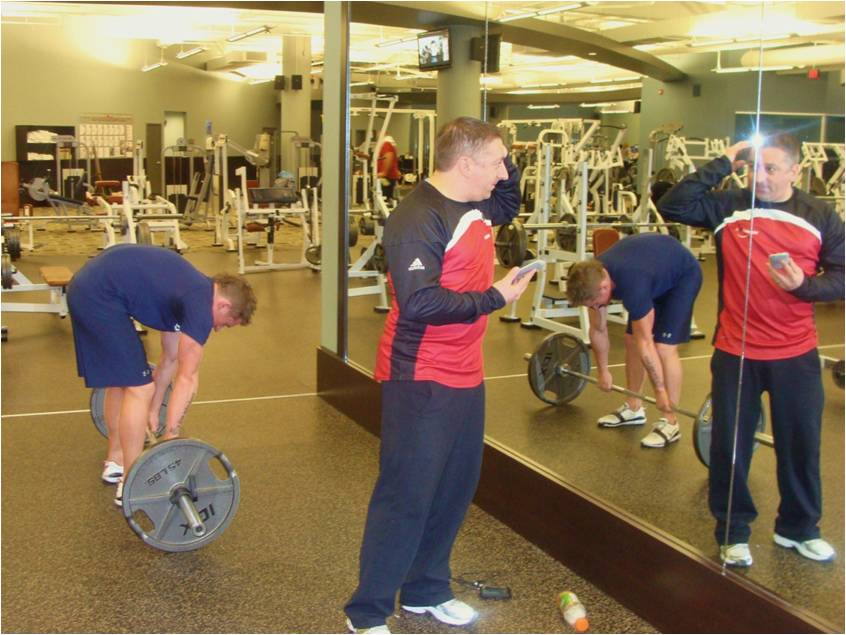The Art of Personal Training
Today’s guest post comes to you directly from Kevin Mullins, the 2014 and 2015 Men’s Health Personal Trainer of the Year. Enjoy!!
The “It” Factor
This time of the year much of the sports media and fans themselves are inundated with the NFL draft. Who is your favorite team going to draft? How fast did so-and-so run their 40 yard dash? On top of the questions, assessments, and reviews of combine performances, pro days, and game tape you’ll also here statements like: “This athlete has the “it” factor.”
In a sport like football it can be sort of easy to describe what that factor is. It is the guy who might not run the fastest, hit the hardest, or even look the part, but for some reason he is always making plays. He is that quarterback that doesn’t get rattled when he is getting hit every play in a close game. He is the defensive back who always seems to get an interception a game. He is the offensive lineman who has played all five positions on the line, studied his way to a 4.0, and volunteered at a shelter when he could.
You get the point.
It’s all those things that don’t have a tangible, scientific explanation. There are no numbers to support what you see – it just is.
What about the field of personal training though?
It isn’t a secret that becoming successful in this industry requires a strong foundation in hard sciences like physics, biology, biomechanics, anatomy, and physiology. One doesn’t need to study in college to gain this information either – it is possible to obtain it on your own through vigorous study. Regardless, that foundation needs to be there. So too does a drive to constantly gain more knowledge and evolve your skill set to better meet any and all client’s needs.
These sciences can measured though. In the words you speak or write, and in the programs you design for your clients. Is everything just bench press and bicep curls, or are you looking out for thoracic mobility, push-pull balance, and developing a unilateral hinge pattern?
At the end of the day a trainer is going to be judged by what they know and what they can provide a client.
Yet, like popular sports there is always more. There are intangibles that can rocket someone to success, help them better reach their clients, and overall provide a better training service.
The Art of Personal Training
It is not a fluke that the word “art” is spelled perfectly, backwards in the word “train”. While this may sound like a corny attempt at having a clever lead-in (it is) – it is also an accurate description of the training experience.
There is always that person who seems like a walking textbook and can explain any training concept that exists, but struggles to succeed as a trainer. They are the most qualified person in the room, but they often get looked over for someone else.
Often times they are incapable of delivering the information that they know to someone else without coming off as pompous, or worse – judgmental. While they possess tremendous academic skill they are lacking in the interpersonal relationship skills that can make training special. In the case of this individual it is imperative that they take the time to reflect on the “personal” aspect of training and realize that they aren’t just inputting training data into a robot.
Just the same, there are plenty of trainers who don’t really know as much about the science of training, but they look the part, talk the talk, and are full of charisma. Their client book can be overflowing – even if they aren’t providing a great “training” experience. For many clients, who know less than even this trainer, a session is an “experience” with someone who is an alpha personality – someone who motivates them.
Ideally, we are not at either end of this spectrum. You don’t want to be the unapproachable book-nerd who talks down to your clients just as you don’t want to be the charismatic fool who eats their fourth meal of the day while their client struggles through an ugly set of planks. Like many other sliding scales you’ll be best served to find yourself towards the middle.
The art of training is the reason they even train with you in the first place. Let’s be honest, most clients do not care that you know exactly how to activate the abductor complex, or that you once wrote an article about all of the muscles in the core.
They just want to sweat a little, smile a lot, and feel like you give a damn about their goals.
Listen and Ask more Questions
All too often trainers act as though they know the answer to every question that a client could pose them. A client speaks up about their back aching and it is immediately answered with a short, “We just need to make your glutes fire and fix your posture”.
There were no follow up questions or any curiosity on behalf of the fitness professional. Just a quick answer that wasn’t necessarily wrong, but certainly wasn’t right.
Behavior like this shows a lack of investment. Your inability to listen presents the image that you don’t actually care about how they are feeling and you are slightly annoyed that they paused to ask you a question. In their eyes – you just want to keep things rolling, so that you can be on to the next one.
They feel like a customer and not a client.
Invest in your clients by asking more questions, inquiring deeper into issues they present you, and by actually listening and remembering what they say.
It is simple really. Make sure the personal side of your training is just as refined as your science by asking questions that allow you to provide a higher level of service than simply executing an exercise program.
3 Ways to put it to Work –
- As Nick Winkleman of EXOS has discussed, many times your clients can provide personal information about them that can lend itself to the cues you’ll use in exercise. Maybe their kid loves Superman, and so “long spine” becomes “look like Superman”. Listen for things that make your coaching about them and not just a series of words about the body.
- With weight loss clients try to find the genesis story. Why did the weight gain start and who was involved in their life? When did they feel like they lost control? What is the one behavior they do every day that they never used to do? Finding out the answers to these questions can help change the language and tone you’ll use in your coaching. It’s critical to maintain a personal touch with individuals who are very self-conscious.
- Ask about current life events. If your client is a heavy traveler, weak sleeper, and has two kids at home that are playing three sports, then chances are that they are falling apart internally. Involving yourself at a basal level in their personal lives can help you understand when to pump the brakes in a session and focus a bit more on regeneration. Just the same, a good weekend of rest for them might make your next session a full throttle adventure.
Exercise should be Hard, but it doesn’t have to be Grueling
It can be a cringe worthy sight to see a new trainer absolutely slaughtering a client during a session, especially if that client is trying to lose any significant weight. Like a relentless dictator the trainer stands over the client barking out commands, numbers, and random chunks of semi-motivational jargon.
No wonder some people have a real phobia of exercise.
Let’s set this straight. Exercise should be hard. Pretty hard for most and moderately challenging for the rest. Yet, that doesn’t mean a session needs to turn into all out warfare on a client’s body.
If you are trying to make your client puke, or break them, then you are a jerk.
If you are programming things that you know a client can’t do just to show off when you demonstrate an exercise, or to make them feel like they need you, then you are a jerk.
A really good trainer knows how to assess a client physiologically. A great trainer knows how to also assess them psychologically. Being able to determine what motivates the client, what they fear, and what their relationship with exercise is can be critical to long term success.
This is especially true with any client that needs to lose considerable weight, has no experience in the gym, or has a history of self-confidence issues. The very last thing you want to do these individuals is make them feel like a failure in their head while simultaneously destroying their body out from under them.
Besides, you’ll know a bad ass client when they step in front of you. They’ll probably be in above-average shape, have some light knowledge on what they are doing, and are already putting forth considerable effort in the gym. These are the people you can “turn the knob” with. Not without planning of course, but these people afford you and opportunity to push the envelope.
With everyone else – there will be times when you can accelerate and there will be times you need to pull the reigns and slow down – know this.
Remember it is always easier to program upwards and progress exercises with a client then it is to regress and lower a program’s expectations. There is nothing to gain from overshooting with a client.
3 Ways to put it to work –
- Ask questions during your assessment about their previous exposure to exercise. Have they ever worked with a trainer or played a collegiate sport? This will help you better understand what they perceive as “hard” and will help you better set your performance expectations for the workout.
- Realize that harder doesn’t always imply going faster, heavier, or doing more total volume. You can make an exercise harder by removing a point of stability (single leg), making the load unilateral, or by adding a lateral or transverse lunge into a movement.
- Remember “WHY” that individual is training at all times. Setting up mega-circuits of death just because you know it’ll wipe them out benefits no one. Think about how you can get them closer to their goal and help them leave the session feeling tired, but not defeated.
Always on Time, Always Prepare
That’s why they point erasers on pencils” – my mother
We are all human. We all make mistakes. It is important to understand this. However, it need not be a habit or an excuse to not perform your best. You can be the best of friends with your client, listen to everything they say, and provide them quality results, but if you aren’t a professional, then you aren’t going to truly succeed.
Every successful trainer has probably overslept a session at least once in their career, especially if they started in their early twenties. At the very least, they’ve double booked or completely forgot that they verbally committed to someone without marking it down.
They do it once though, and make sure to never repeat it again. There are others, however, that make lateness, missed sessions, and poor planning a habit. Always running in five minutes late, always saying sorry…it is unprofessional.
More likely than not, these same trainers often train without a program for their client. Instead they decide to wing every session and see where the hour takes them. They are probably out of uniform on occasion, and have probably charged a client when they shouldn’t have.
Simply put, they aren’t very professional.
A great trainer takes care of the little things that are absolutely in their control. They make sure that they are there for the start of every session, program ready to go, in uniform (or gym appropriate attire if you are private), and excited to see you.
This doesn’t need much more explaining. You are a professional. Do your job.
3 ways to put it to work –
- Always be in the gym about fifteen minutes prior to your first session. Don’t scramble in franticly and expect your client to want to jump through hoops for you until you prove you want to be there. Being ready to rock before your client even walks in shows that you value them, and that you are ready to put forth a great training session.
- Program sessions for three to six weeks in advance. This will allow you to actually create a training program instead of just stringing together a series of workouts. Furthermore, you’ll be able to focus on specific variables in each three to six week cycle.
- Put the coffee or energy drink down. Caffeine is to trainers as electricity is to a light bulb. Yet, sipping on your coffee while staring at your client doing repetitions says “I need this to deal with you”. Drink your beverages prior to the session. Pro Tip: Washable bottles that aren’t see through can hold everything from water, pre-workout, amino acids, and even your beloved coffee.
Be Authentic to You
The stupidest phrase in the English vernacular is “fake it until you make it”. Jokingly it can be funny and appropriate on a long day that was short on sleep. As a motto for how you approach your personal training career it is ridiculous.
The fastest way to be successful (and happy) is to be yourself.
Don’t lie about what you lift, say you only eat tuna and broccoli, or act like you’ve never skipped a workout. Be a human. More importantly, be honest.
I believe it was the Rock who coined the term “jabroni”. Don’t be a jabroni.
Be able to look your client in the eyes and tell the truth. They might not have a degree in exercise physiology, but they have a pretty good idea of what a guy who can bench press four hundred pounds looks like. Furthermore, they saw you across the street slamming a burger and fry once, and so you look an idiot when you say you “never” have cravings for fast food.
Authenticity is the rarest commodity in today’s world. Everyone, including myself, is spending time carefully curating their social media profiles and making sure people only see what they want them to see. In this context there is no worse realm than fitness. With Instagram butt photos, schmedium t-shirts and shadows to create muscularity, and never admitting you have a bad day too – fitness is full of a bunch of fools.
If you want to make the next leap in your career try looking less at the letters behind your name and more at the person who carries that name. Are you likeable? Are you honest? Do you let your clients know those little details about you that make them respect you as a fellow homo sapien?
This isn’t an invitation to narrate a tell-all book while your client is trying to bench press. Rather, it is a strong suggestion to let your client know that you can relate to them whenever appropriate. Much like being a better listener can help someone feel like you care, showing vulnerability can make a client like you more and be willing to work a little bit harder, or at least combat you less.
It doesn’t matter what it is that makes you unique. It only matters that you allow yourself to stand out with your uniqueness instead of having the personality of a potato. People eat potatoes. They don’t talk to them. They don’t pay them either.
3 ways to put it to work –
- Don’t even talk about your workouts, lifts, or diet unless your client specifically asks. Even then, focus on the general details and not the specifics. It’s not about you and your accomplishments. Talk about the lessons you learned during last one-rep squat, and not the amount of plates that were on it.
- Live the life you preach. Preach the life you are living. Nothing will sound better coming from a fitness professional than a truthful statement about their approach to health and wellness. If you don’t really drink alcohol, but occasionally crave a calorie bomb burrito – share that. Let your client know that you are a normal person and not a cyborg who only eats boiled chicken and greens.
- Don’t be afraid to show your depth. If you love classical music and you are with a client who does too – open up about it. Maybe share collections, etc. Do not go too far and lesson the value of the professional service by spending more time talking than training, but allow your clients to see that you are a human being that thinks about more than just weights and cardio.
About the Author
Kevin Mullins, CSCS is a Tier 3+ coach for Equinox Sports Club in Washington D.C. A B.S. in Kinesiology from the University of Maryland serves as the scientific foundation for the following certifications – ISSA certified Personal Trainer, USAW Level 1 Sports Performance, and Precision Nutrition Level 1.
Kevin writes for multiple resources and has been featured by PTontheNet, the PTDC, Men’s Health, Women’s Health, the Washington Post, and local television outlets. He was selected as Men’s Health Next Top Trainer in 2014 and 2015.
Kevin maintains his own site at KevinMullinsFitness.com



